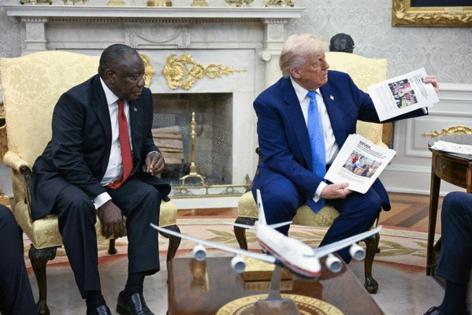Trump looks to slash refugee count, will favor Afrikaners
Published in News & Features
WASHINGTON — President Donald Trump is considering imposing a massive drop in the cap for refugee admissions from 125,000 to 7,500 and is expected to favor white South Africans over immigrants fleeing war or famine, according to people familiar with the matter.
The new number, described by people who asked for anonymity to discuss private deliberations, would mark a record low in refugee admissions to the United States. It comes in a presidential determination dated Sept. 30, which Trump signed, according to The New York Times, which first reported the change.
The number could change in consultation with Congress. But an administration official said Saturday, speaking on condition of anonymity, that the shutdown prevented those talks from happening, and that no refugees would be admitted until the government was open.
Trump in May welcomed dozens of white Afrikaners, insisting without evidence that they faced racial discrimination, land grabs and violence, calling it “genocide.” In fact, young Black men bear the brunt of crime in South Africa, and there have been no official land grabs since apartheid ended there in 1994.
The South African government has denied any racial discrimination, and in a heated Oval Office meeting with Trump, South African President Cyril Ramaphosa attempted to debunk claims made by U.S. officials of genocide against white South Africans.
The new figure would mark the latest move by the administration to restrict legal migration to the U.S. Trump on Sept. 19 signed a proclamation requiring for a $100,000 fee to acquire an H-1B visa, the kind used by high-skilled workers, such as doctors and engineers.
The cut in refugee admissions would mark a drastic 94% reduction from last year, when a presidential determination authorized admission of as many as 125,000 refugees.
The determinations were based on prevalence of “special humanitarian concern,” according to the document.
Trump campaigned on curtailing illegal immigration, but since entering office in January he’s broadened that scope. He’s issued a new travel ban and is challenging the constitutional right to birthright citizenship under the 14th Amendment. Among his targets for deportation are students, green-card holders and nearly anyone in the U.S. without permission.
Upon entering office, Trump signed an executive order indefinitely halting all refugee admission, which was promptly challenged in court. An appeals court allowed new admissions to be paused as the litigation continues but ordered the government to provide services to refugees who already had arrived.
Trump later signed the separate executive order that prioritized “humanitarian relief, including admission and resettlement through the United States Refugee Admissions Program,” for white South Africans.
“A record-low refugee admissions goal aligns with this administration’s consistently bad-faith approach to refugee and humanitarian protections, jeopardizing people’s lives, separating families, and undermining our national security and economic growth,” John Slocum, executive director of Refugee Council USA, said in a statement.
Shawn VanDiver, who founded AghanEvac, a nonprofit that helps support Afghan allies and refugees who assisted the U.S. in the war there, condemned the move.
“Turning our back on allies and partners makes us less safe,” he said. “Failing to meet workforce needs weakens our economy.”
Traditionally, administration officials are required by law to consult House and Senate Judiciary committees on refugee determination before the start of the fiscal year on Oct. 1.
The Trump administration hadn’t briefed congressional committees on the number of refugees allowed in the U.S. next fiscal year, Bloomberg reported.
©2025 Bloomberg L.P. Visit bloomberg.com. Distributed by Tribune Content Agency, LLC.







Comments